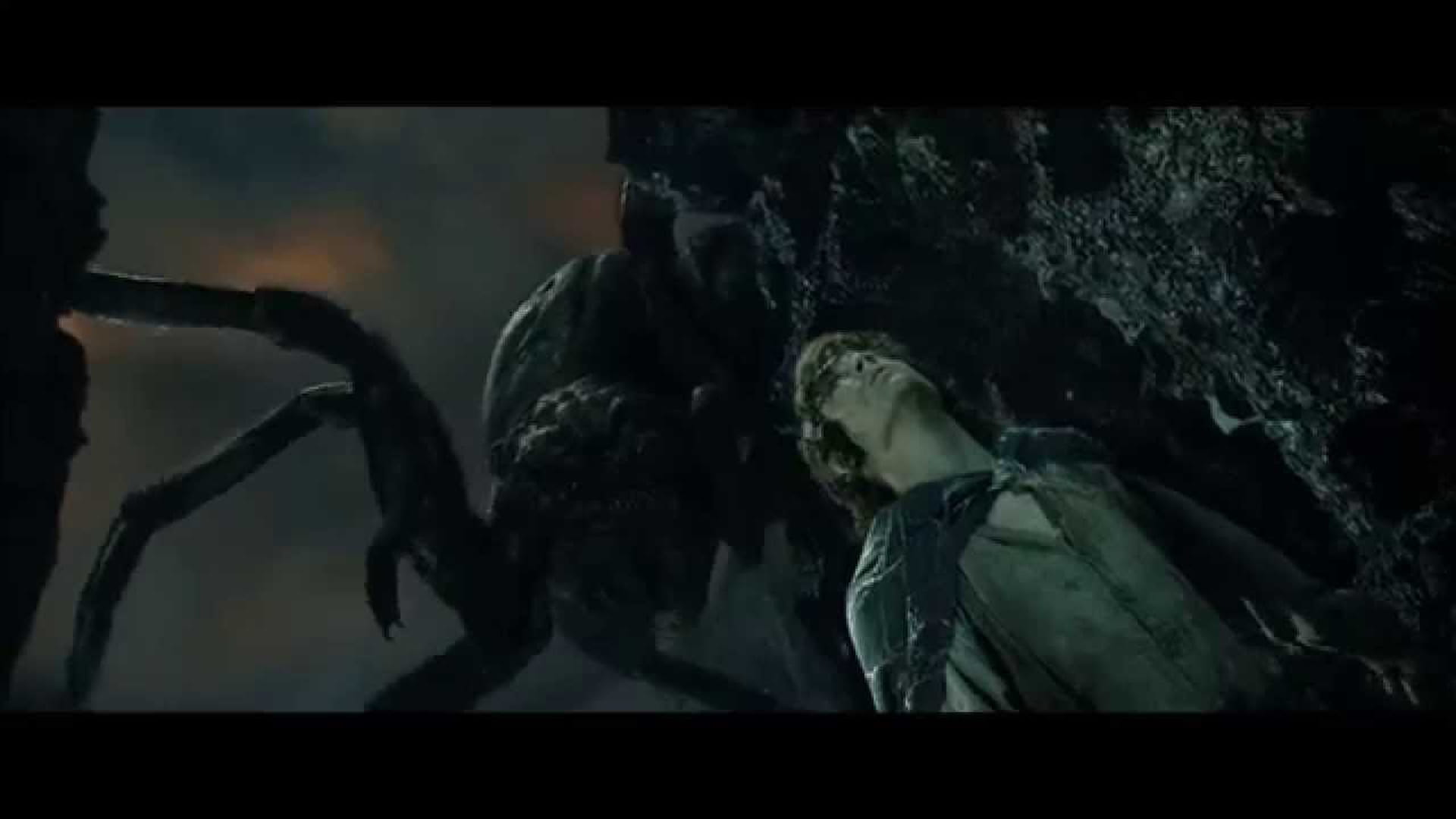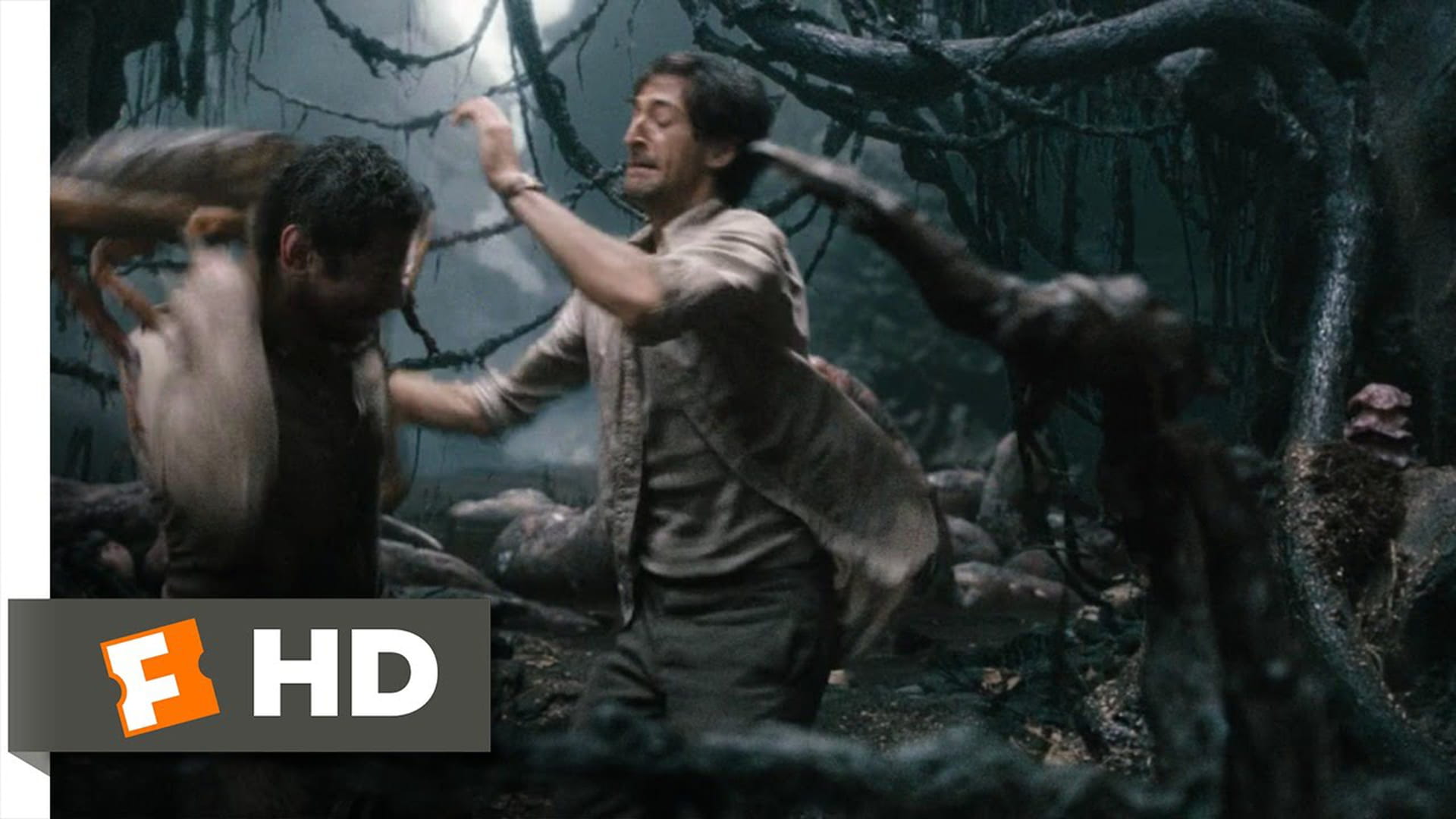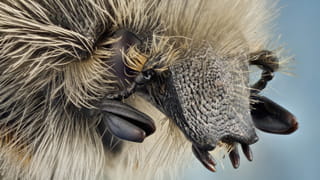It was my first real Matrix moment. One of those instants when you suddenly realise something and there’s no turning back: you’ll always see things differently.
That was when I discovered, more or less by accident, that humans pretty much hate almost all animals on earth.
What, all animals? Well, invertebrates. Spiders, insects, jellyfish, crabs, worms, molluscs – in other words, animals without a backbone, which make up 98% of all animal species. Why, though?
Because invertebrates have a PR problem. It’s been like that for centuries.
Shouldn’t we work on this? After all, there may be a connection between this image issue and the mass insect deaths, which have been causing considerable panic for some years now. A chronic lack of good insect PR may be fatal – for more lifeforms than just insects.
Seven of Nine as mini-moth
My initial interest in the world of insects was triggered by something completely different: cyborgs.
In early 2012, a US American chemist managed to build a mini-fuel cell that converts sugars in the stomach of a cockroach into a 0.2 volt current. It was the umpteenth step in a global scientific project to create cyborg insects. To engineer insect/machine hybrids bejewelled with sensors and cameras that could be controlled remotely. And then maybe hunt down terrorists. Great. Something like Seven of Nine from Star Trek in insect form. I wrote about it for a magazine.
Then readers wanted to know: is this even legal? I investigated, and yes, you can do whatever you want with insects. Pull them apart, turn them into cybugs: insects are not supposed to experience any relevant form of pain, in a legal sense. That’s why there is no legislation protecting them.
But here’s the thing … this doesn’t just apply to insects but to all invertebrate species – to the 98%. When the law speaks of "animals", only the 2% "our kind of species" are meant – the vertebrates.

Why? Is it true those other species don’t feel pain? What really surprised me was that I couldn’t find any scientific proof backing this claim. The tiny amount of research into pain experience among lobsters, crabs and squids – also invertebrates – only shows their pain is about as real as that of dogs.
Nobody knows what the deal is with insect pain. And by extension, how to protect them. And even if we did know – who cares?
But ever since I started caring, I’ve spoken to countless insect scientists – entomologists – who are becoming increasingly adamant. Caring for insects? We’ll have to.
This will prove a pretty daunting task for humanity. According to entomologist Jeffrey Lockwood, people are simply "disgusted" by invertebrates. We associate them with rotting meat, death, diseases and faeces, with endless reproductive abilities and an unhealthy lack of respect for personal space. They live in our pubic hair and our anuses. Everywhere. Lockwood wrote a book on the topic: The Infested Mind: Why Humans Fear, Loathe, and Love Insects (2013).
I read it. And there was my Matrix moment: suddenly, I saw our insect repulsion manifest itself everywhere.
Just think of the best-selling book of all time: the Bible. Filled with references to insects. All of them negative. God visits three hornet plagues upon mankind as a punishment. The prince of demons is referred to as the “Lord of the flies” – Beelzebub, who feasts on shit. For a long time, people believed insects arose from the collected sins in a corpse.
Post-Bible, Hollywood treats us to an almost endless series of horror and sci-fi movies full of creatures that make human life miserable, created in the image of invertebrates.

The computer beasts from The Matrix? A cross between flying spider heads and squids with dozens of tentacles, which cultivate humans as if they were larvae in vast egg fields reminiscent of insect colonies.
The xenomorph from Alien? A human/insect hybrid that lays eggs in its hosts, after which the larva eats the hosts from the inside and rips out of their bodies, based on the tactics of the parasitic wasp.
The alien race from Paul Verhoeven’s Starship Troopers is nothing more than a collection of overgrown insects with toxic green blood. And how many Indiana Jones, Lord of the Rings and Harry Potter scenes feature heroes in a valley, being overrun by either a mass of tiny crawling ants, or one terrifyingly large spider?
Perhaps there’s only one group that gets an even worse rap in Hollywood films: Arabs.

Not enough legs – or too many
Hollywood does what it does best: confirm and reinforce latent fears. But where does our fear of insects even come from?
"It’s in our nature to quickly learn to be fearful about things that don’t resemble us at all," says Lockwood. For example, it is easier to teach a child to be repulsed by something slippery and slimy than by something warm and fluffy. Regardless, research shows children seem to be more alert to creatures with either too many legs, such as insects, or too few, such as snakes.

And to be fair, some insects do deserve their bad reputation. At the end of the 19th century, links between diseases and insects were discovered, such as malaria and mosquitoes. And with the rise of industrial agriculture, insect infestations became costly affairs.
So for a long time, fewer insects on earth seemed like a good idea. In fact, billions of dollars have been – and are being – spent exterminating insects every year. But not only that, entomology originally was the study of extermination. The better you understand insects, the more efficiently you can eradicate them. Destruction is still a major driver for insect research.
However, changes are happening. In 2017, German research found that over a period of 27 years, more than 75% of all insect biomass had disappeared from German natural reserves.
A few years earlier, British researchers discovered that the total number of invertebrates – not only insects – in cereal fields in southern England had shrunk by a third in just over 40 years.
Looking outside Europe, it was reported in 2018 that in the last 40 years the number of insects in the Puerto Rican rainforest has reduced by a factor of 10 to 60.
Ask scientists about today’s biggest problem and almost all will answer: climate change. But more and more entomologists are saying: this is mass extinction, or "insectageddon".
Because insects are the caretakers, cleaners, waste processors – without them, no process on Earth would run smoothly. A habitable planet requires plants, insects and microbes, and lots of fungi. The rest is a bonus. Thanks to the indispensable foundation laid by those billions of insects, the birds, mammals and humans that came after could – and can – flourish.

A harrowing lack of dung beetles
This is abundantly clear when we look at the European colonisation of Australia.
In the late 19th century, Europeans introduced livestock to Australia. In no time, large areas of the country were buried under a thick layer of excrement. Permanently. The reason? Australian dung beetles had never seen a cowpat in their lives, and weren’t interested. They were more into wombat and kangaroo poo.
So the Australian Dung Beetle Project was devised, which imported dung beetles from all over the world that were used to eating cow shit to clear many acres of grassland of cow shit.
Or take the ants in Manhattan. Every year, they eat an amount of fast food equivalent to 60,000 hot dogs from the streets of New York.
People tend to think insects are necessary for the pollination of our crops and beautiful flowers. They believe that if insects didn’t do this, we wouldn’t have anything to eat. And to an extent this is true.
But more importantly: insects play an essential part in the recycling of nutrients that would otherwise be left inside dead trees, dead animals, or simply poop. These nutrients are needed for new seeds, new trees, and new life. Without insects, Earth would suffocate beneath a thick layer of dead material and human waste.
That should come as no surprise, since insects have been ploughing away for at least 480 million years to shape the green planet that Earth is today. Insects created all ecosystems above the sea. If they disappeared, nature as we know it would cease to exist.

Before the insects, there was drought
Before insects arrived, the land was barren and dry. Interaction between plants and invertebrates created a layer of fertile soil, which began along the coastlines. Gradually, plant-insect communities colonised inland territories, aided by bacteria and fungi.
And 354 million years ago, insects began to fly too. Long before birds, bats or flying dinosaurs, they alone ruled the skies. That’s how flower-bearing plants, which depend on flying insects for pollination, came to be. Only plants can make biomass from sunlight, carbon dioxide and water. Not all animals can eat all plants. Insects are the class that connects all ecological layers. They process dead material so that new plants can emerge and are also food for carnivores.
Anyway, don’t stop caring about pandas. But if you want to save ecosystems, you’re better off worrying about bugs.

British nature researcher Christopher Packham once suggested he would "eat the last panda", so that the money spent on panda protection could go to less photogenic species, which have a real chance of survival outside the zoo and make an actual contribution to some ecosystem or other.
I see his point.
In 2018, ecologists compared the media attention for climate change to coverage of the collapse of insects and other types of biodiversity. In English-language media, there was eight times as much focus on climate change than on the disappearance of life.
This has an effect on the amount of available research funding, and subsequently on the amount of research that can be carried out – and, as a result, on the level of publicity. Right now, we have no idea how the insect populations are really doing. Poor PR, no attention, no money, and no research means no idea.
Crochet cuddly woodlice
All the entomologists I spoke to are placing their hope in the next generation. What to tell them? Norwegian entomologist Anne Sverdrup-Thygeson knows what to do. She recently wrote an expansive ode to insects, Terra Insecta (2018).
"Can’t we tell teenagers that many types of yeast required for beer hibernate in the wasps’ stomachs?" suggests Italian wasp researcher Alessandro Cini. "We have to allow the youth to interact with large, slow insects, such as the hissing cockroach," says Lockwood, who recently wrote an opera about locusts, which was staged in Wyoming, USA.
Learning to appreciate spineless creatures cannot start early enough. Sometimes I toy with the idea of making an animal-counting book featuring giant woodlice, jellyfish, corals, nautiluses, beetles, crabs, seafarers, all those kinds of animals, instead of the usual ducks and frogs or lions and tigers.
In my direct environment, re-education is in full swing. I’m 32 and my friends and family are starting to reproduce. So I write the same message on every congratulations-on-your-baby card (think cheerful yellow envelope with a stylised spider): "Make sure to instil the miracle of invertebrates in baby X!"
The other day I gifted a stuffed jellyfish to a close high school friend for her newborn, Rosa. (Welcome to Planet Insect, Rosa!) No idea where the next baby will turn up, but this I promise the tiny human: a cuddly wasp.
More invertebrate horror?



Dig deeper
 Climate change is only half the problem. We’re destroying the Earth’s layer of life
Along with the climate crisis, the disappearance of non-human life is our most pressing problem. To fully understand how big the problem is, we need to think of this loss in terms of biomass instead of the number of species.
Climate change is only half the problem. We’re destroying the Earth’s layer of life
Along with the climate crisis, the disappearance of non-human life is our most pressing problem. To fully understand how big the problem is, we need to think of this loss in terms of biomass instead of the number of species.


